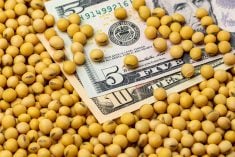Western Canadian feeder cattle continue to drift lower amid higher feed costs and softer fed cattle prices. The barley harvest has started in Manitoba and will be more widespread in a couple of weeks. However, feed prices remain near historical highs. U.S. values were down $3/cwt to $5/cwt on average as ongoing drought conditions plague the corn belt and the southern Plains.
Weakness in the U.S. market continues to spill over into Western Canada which will likely continue into the fall. Pasture conditions across the Canadian Prairies are still quite good for this time of year, limiting the number of feeder cattle coming on the market. Low volumes were recorded at most auction markets with no main features to report.
Read Also

U.S. grains: Soy futures post biggest monthly gain in nearly five years on China trade optimism
U.S. soybean futures climbed to a 15-month high and posted their biggest monthly gain in nearly five years on Friday following a rally fueled by the prospect of revived exports to China.
In central Alberta, top-quality steers weighing 600 to 700 pounds sold in the range of $150/cwt o $160/cwt; 700 to 800 pounds replacement steers were quoted from $136/cwt to $155/cwt. Alberta packers were buying fed cattle in the range of $109 to $110, down $1/cwt on average from week ago levels.
There were 97.8 million head of cattle in the U.S. as of July 1 2012, down two per cent from July 1 of 2011. The USDA semi annual cattle inventory report showed that the cattle herd continues to contract and the 2012 calf crop is projected to come in at 34.5 million, down 2.4 per cent from 2011. Beef cows were down three per cent from last year while the number of heifers for beef cow replacement were virtually the same as last year. This may change on the January report given reports of massive herd liquidation due to the widespread drought.
The corn market appears to be making another leg higher as the market digests lower yield estimates. I’m expecting record-large Canadian feed grain exports to the U.S. this fall which will weigh on domestic feeder values. Feeder cattle prices have potential to be down 10 per cent to 20 per cent this fall. Feeder cattle prices could experience a year-over-year decline of 25 per cent in the first quarter of 2013. The world cannot afford a crop problem in the Southern Hemisphere.












